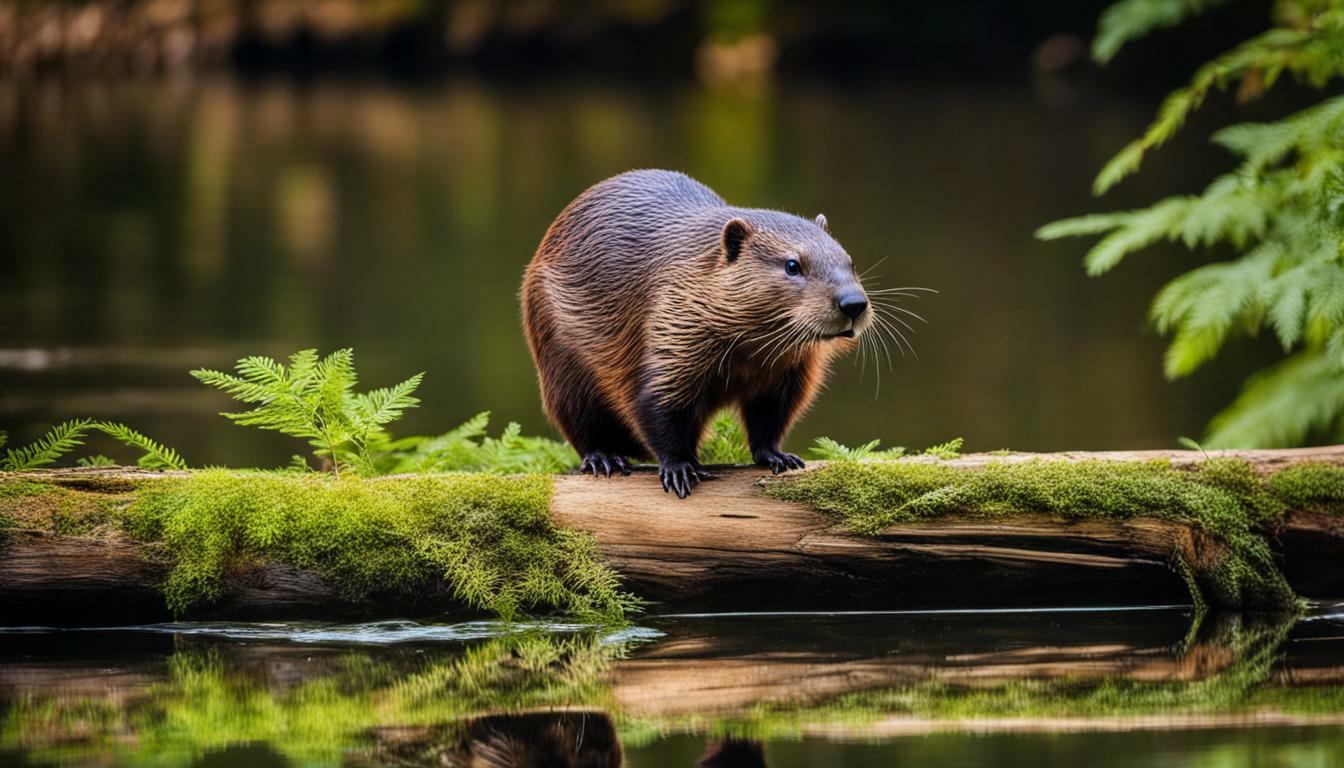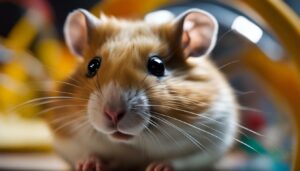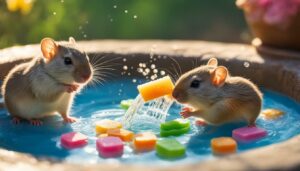Have you ever wondered if beavers have good eyesight? Let’s explore the truth behind their visual capabilities.
Key Takeaways:
- Beavers do not have good eyesight.
- They have poor vision both during the day and at night.
- Beavers are nearsighted mammals with tiny black eyes.
- They have adapted to become nocturnal animals over time.
- While beavers can see while swimming underwater, they lack night vision.
- Beavers rely on their other senses, such as touch, smell, and hearing, for navigation and survival.
Understanding Beaver Eyesight
To understand beaver eyesight, it’s important to explore how well they see and how their eyes function. Beavers do not have good eyesight compared to humans and many other animals. Their vision is poor both during the day and at night, with limited visual acuity.
Beavers have small black eyes, which are more suited for daytime activities. They are nearsighted mammals, meaning they can see objects near to them more clearly than those far away. This nearsightedness is due to the shape of their eyes and the way light is focused onto their retinas.
Over time, beavers have adapted to become nocturnal animals as a survival mechanism. They have become more active during the night to avoid hunting and persecution by humans. However, even though they are active at night, beavers do not have the reflective tissue behind their eyes that allows for night vision. As a result, their visual capabilities are greatly reduced in low-light conditions.
| Beaver Eyesight Summary |
|---|
| Beavers have poor eyesight both during the day and at night. |
| They are nearsighted mammals with small black eyes. |
| Beavers have adapted to become nocturnal animals. |
| They do not have the reflective tissue behind their eyes for night vision. |
| Beavers rely on their other senses, such as touch, smell, and hearing, for navigation and survival. |
Despite their limitations in eyesight, beavers have managed to thrive and survive thanks to their other senses. They heavily rely on their sense of touch, using their sensitive front paws to manipulate objects and build intricate dams and lodges. Their acute sense of smell helps them detect danger and locate food sources, while their sharp hearing allows them to pick up on sounds that may indicate potential threats.
In conclusion, while beavers may not have good eyesight, they have adapted to rely on their other senses for their survival. Their nearsightedness and lack of night vision have pushed them to become primarily nocturnal animals, with their eyes more suited for daytime activities. Despite these limitations, beavers continue to thrive in their aquatic habitats, using their senses to navigate and thrive in their environment.
Adaptations for Daytime Activities
Beavers have unique adaptations that allow them to carry out their daytime activities effectively, but is their visual acuity as keen as other animals? Let’s explore their eyesight and see how it contributes to their survival in their natural habitat.
Although beavers have poor vision, their eyes are well-suited for their daytime activities. These small, black eyes provide them with basic visual information, allowing them to navigate and carry out tasks such as building dams and constructing lodges. While their vision may not be as sharp as some other animals, beavers compensate for this through their remarkable sense of touch, smell, and hearing.
Beavers rely on their keen sense of touch to feel their way around their surroundings, particularly in the water where they spend much of their time. Their highly sensitive paws enable them to detect vibrations and changes in water currents, allowing them to navigate through their aquatic environment with precision. Additionally, their acute sense of smell helps them locate food sources and detect potential danger.
| Visual Acuity: | Poor |
|---|---|
| Sense of Touch: | Keen |
| Sense of Smell: | Acute |
| Sense of Hearing: | Sharp |
Beavers’ reliance on these other senses, in combination with their unique adaptations for daytime activities, allows them to thrive in their natural habitat. Their ability to build complex structures and modify their environment showcases their resourcefulness and ingenuity.
Summary:
- Beavers have poor visual acuity but make up for it with their other senses.
- Their small black eyes provide basic visual information for daytime activities.
- Beavers rely on their highly sensitive paws, acute sense of smell, and sharp sense of hearing.
- These adaptations help them navigate, locate food, and detect danger in their environment.
Nearsightedness: Beavers’ Limited Visual Acuity
Beavers, despite their amazing abilities, are actually nearsighted mammals with limited visual acuity. Their tiny black eyes are not geared for clear vision, both during the day and at night. While their eyes are more suited for daytime activities, their visual capabilities remain compromised.
Due to their nearsightedness, beavers have adapted to become nocturnal animals over time. This adaptation is a response to the hunting and persecution they have faced from humans. By being more active at night, when their predators are less likely to spot them, beavers increase their chances of survival.
When it comes to underwater vision, beavers have a unique advantage. They can see while swimming underwater, which aids them in their construction efforts and foraging. However, beavers do not possess the reflective tissue behind their eyes that allows for night vision. As a result, they rely heavily on their other senses, such as touch, smell, and hearing, to navigate and survive in their environment.
| Beaver Eyesight: | Key Points: |
|---|---|
| Nearsightedness | Beavers have limited visual acuity and are nearsighted mammals. |
| Nocturnal Adaptation | Beavers have adapted to become nocturnal animals to avoid predators. |
| Vision Underwater | Beavers can see underwater but lack night vision. |
| Reliance on Other Senses | Beavers heavily rely on touch, smell, and hearing for navigation and survival. |
While beavers may not excel in the realm of eyesight, they have developed remarkable abilities in other areas, such as dam-building and ecosystem engineering. Their nearsightedness has not hindered their success in creating complex structures and transforming their environment to suit their needs. These industrious creatures continue to thrive, adapting to their surroundings and relying on their unique set of sensory skills.
Nocturnal Adaptation
Due to hunting and persecution by humans, beavers have adapted to become primarily nocturnal animals, but how does this affect their vision? Let’s explore the sight capabilities of these fascinating creatures.
Beavers have poor vision both during the day and at night. Their tiny black eyes are more suited for daytime activities, but they have adapted to a nocturnal lifestyle over time. While beavers can see while swimming underwater, they lack the reflective tissue behind their eyes that allows for night vision.
Without the ability to see clearly in the dark, beavers rely heavily on their other senses. Their sense of touch helps them navigate and build their intricate dams, while their acute sense of smell guides them to food sources and protects them from predators. Additionally, their keen hearing enables them to detect potential dangers and communicate with other beavers in their colony.
Table: Beaver Sight Capabilities
| Aspect | Capability |
|---|---|
| Daytime Vision | Poor |
| Night Vision | Limited or absent |
| Underwater Vision | Present, but not enhanced |
| Reliance on Other Senses | High |
While their vision may be lacking, beavers have successfully adapted to their environment through their remarkable sense of touch, smell, and hearing. These adaptations allow them to thrive, even in the cover of darkness.
Vision Underwater
While beavers are primarily terrestrial animals, they also rely on their vision while swimming underwater – let’s find out how they do it. Beavers have developed unique adaptations that allow them to navigate and thrive in their aquatic environment.
Underwater, beavers rely on their strong sense of touch and their keen ability to sense pressure changes in the water. Their eyes, although small and black, play a crucial role in helping them locate food, avoid obstacles, and interact with their surroundings. They have a transparent membrane called the nictitating membrane that acts as a protective barrier for their eyes while underwater. This membrane allows them to see clearly and prevents their eyes from getting irritated or damaged.
A beaver’s eyes are positioned on the sides of its head, providing them with a wide field of vision. This panoramic view allows them to have a 180-degree peripheral vision, enabling them to spot potential predators or intruders while submerged. They can also judge distances accurately in the water, which helps them navigate through their complex underwater surroundings without difficulty.
| Beaver Sight Capabilities | Description |
|---|---|
| Underwater vision | Beavers can see clearly underwater due to their nictitating membrane, allowing them to locate food and navigate efficiently. |
| Peripheral vision | Beavers have a wide field of vision, enabling them to spot potential threats while underwater. |
| Accurate depth perception | Beavers are able to judge distances accurately, helping them navigate through their underwater environments with ease. |
Although beavers do not possess the reflective tissue behind their eyes that provides night vision, their visual adaptations have allowed them to thrive in their aquatic habitats. They have become master architects, building dams and lodges that provide them with protection and access to food. While their vision may not be as sharp as some other animals’, beavers have successfully adapted and rely on their other senses to compensate for their limitations.
Lack of Night Vision
Unlike some other nocturnal animals, beavers do not possess the reflective tissue behind their eyes that grants them night vision. This means that when the sun goes down and darkness sets in, beavers face challenges in navigating their environment. Their eyes, while adapted for daytime activities, are ill-equipped for low-light conditions.
Beavers have tiny black eyes that offer limited visual acuity, making it difficult for them to see clearly at night. This lack of night vision is a result of their evolutionary adaptations as semi-aquatic mammals. Over time, beavers have become primarily nocturnal creatures in order to avoid hunting and persecution by humans, as well as to take advantage of the safety and resources that darkness provides.
While beavers may struggle with their vision at night, they have compensated by relying on their other senses. Their highly sensitive sense of touch allows them to navigate and explore their surroundings, while their acute sense of smell helps them locate food and detect potential threats. Additionally, beavers have excellent hearing, which enables them to detect the slightest sounds and movements in their environment.
| Beaver Vision | Key Points |
|---|---|
| Daytime Vision | Beavers have poor vision during the day as well. Their small black eyes offer limited visual acuity. |
| Nearsightedness | Beavers are nearsighted mammals, which means they struggle to see objects clearly at a distance. |
| Nocturnal Adaptation | Beavers have adapted to become primarily nocturnal animals, relying on their other senses for survival. |
| Vision Underwater | Beavers can see while swimming underwater, but their vision is still limited compared to other aquatic animals. |
Overall, while beavers may not have good eyesight, they have successfully adapted to their environment by relying on their other senses. Their lack of night vision is compensated by their acute sense of touch, smell, and hearing, which help them navigate, find food, and stay safe in their unique habitats.
Reliance on Other Senses
Despite their limited eyesight, beavers have honed their other senses to compensate and navigate their surroundings effectively. These aquatic mammals have developed a keen sense of touch, which helps them detect changes in water currents and vibrations caused by approaching predators or potential threats. Their sensitive front paws, equipped with long claws, allow them to explore and manipulate objects in their environment, aiding in their construction of dams and lodges.
In addition to touch, beavers rely on their sense of smell to locate food sources and establish their territories. They have a highly developed olfactory system, enabling them to detect scents from afar. By sniffing out specific tree species or the scent of running water, beavers can identify suitable timber for their dam constructions or find new areas to expand their territory.
Beavers also possess acute hearing abilities that play a crucial role in their survival. Their ears are positioned on the sides of their head, allowing them to detect sounds in various directions. This helps them discern the approach of both land and water-based predators, enabling a swift escape or defensive response. Furthermore, their ability to detect subtle changes in the pitch and tone of sounds allows them to communicate with other beavers, maintaining social cohesion within their family units.
Overall, while their eyesight may be lacking, beavers have developed impressive sensory adaptations that enable them to thrive in their aquatic habitats. By relying on their heightened sense of touch, keen sense of smell, and acute hearing, these industrious creatures navigate their surroundings with remarkable effectiveness, making the most of their environment and ensuring their survival.
| Senses | Role |
|---|---|
| Touch | Aids in detecting water currents and vibrations, assists in construction activities |
| Smell | Locates food sources, identifies suitable timber, and helps establish territories |
| Hearing | Alerts to the approach of predators, facilitates communication with other beavers |
Evolutionary Implications
The limited eyesight of beavers may have played a role in their evolution as they adapted to their specific ecological niche. Unlike many other animals, beavers have poor vision both during the day and at night. Their eyes are small and black, indicating their nearsightedness. This visual impairment has likely influenced their behavior and survival strategies throughout history.
As primarily aquatic mammals, beavers rely heavily on their environment for sustenance and safety. Their poor eyesight may have led them to develop other sensory mechanisms to compensate for their visual limitations. By relying on their sense of touch, smell, and hearing, beavers have been able to navigate and thrive in aquatic habitats, where they build intricate dams and lodges for protection and shelter.
The evolutionary adaptation of beavers to become nocturnal animals may also be linked to their visual impairment. With hunting and persecution by humans as potential threats, beavers have likely adapted their behavior to be more active at night, when they can rely on their enhanced senses to detect danger and evade predators. This shift in activity patterns could have helped ensure their survival and allowed them to continue thriving in their habitats.
| Implications of Beaver Eyesight |
|---|
| 1. Beavers have evolved to rely on senses other than vision for survival. |
| 2. Their inability to see well in low light conditions may have led to their nocturnal behavior. |
| 3. Beavers’ reliance on touch, smell, and hearing may have influenced the development of their dam-building and lodge construction skills. |
| 4. The evolution of beaver eyesight showcases the adaptability of animals to their unique ecological niches. |
The Importance of Eyesight for Beavers
While beavers may not have the best eyesight, their visual abilities still play an important role in their survival and activities. Despite their poor vision, beavers have adapted to make the most of their limited eyesight in order to navigate their surroundings and carry out essential tasks.
One of the primary functions of beaver eyesight is assisting in daytime activities. Beavers have small, black eyes that are better suited for bright light conditions. Their visual acuity allows them to locate suitable wood for building dams and lodges, as well as foraging for their preferred food sources.
Another crucial aspect of beaver eyesight is their ability to see underwater. Beavers are exceptional swimmers and spend a significant amount of time submerged. Their eyes are adapted to function effectively in the aquatic environment, enabling them to effectively navigate and locate food while swimming.
Table: Beaver Vision Abilities
| Visual Ability | Description |
|---|---|
| Daytime vision | Beavers have adapted to see well during daylight hours, allowing them to engage in activities such as building dams and foraging for food. |
| Underwater vision | Beavers possess the ability to see underwater, which is essential for their survival as they spend a significant amount of time swimming. |
| Night vision | Beavers do not have the reflective tissue behind their eyes that allows for night vision. Instead, they rely on their other senses, such as touch, smell, and hearing, to compensate for their limited vision in low-light conditions. |
While beavers may not have the best eyesight overall, their visual abilities allow them to carry out important tasks during the day and underwater. Additionally, their reliance on other senses showcases their adaptability and resourcefulness in navigating their environment. Despite their visual limitations, beavers have successfully survived and thrived due to their remarkable ability to adapt and utilize multiple senses for their daily activities.
Conclusion
In conclusion, despite their poor vision, beavers have adapted to thrive using their other senses, making them truly fascinating creatures of nature. Beavers have tiny black eyes that are more suited for daytime activities. They are nearsighted mammals, which means their visual acuity is not very sharp. However, they have evolved to become nocturnal animals over time due to hunting and persecution by humans.
While beavers can see while swimming underwater, they lack the reflective tissue behind their eyes that allows for night vision. This means that they cannot see well in the dark. However, beavers compensate for their limited eyesight by relying on their other senses, such as touch, smell, and hearing. These senses are crucial for their navigation and survival in their natural habitat.
Despite their visual limitations, beavers have managed to thrive in various environments by utilizing their other sensory abilities. They have adapted to their surroundings and developed an impressive set of skills to build dams, construct lodges, and navigate through their aquatic habitats. Their ability to rely on their other senses demonstrates the resourcefulness and resilience of these remarkable creatures.
So, while beavers may not have good eyesight, they have found innovative ways to overcome this challenge and flourish in their natural habitats. Their unique adaptations and reliance on other senses make them a true marvel of the animal kingdom.
FAQ
Do beavers have good eyesight?
No, beavers do not have good eyesight. They have poor vision both during the day and at night. Their eyes are more suited for daytime activities.
Are beavers nearsighted?
Yes, beavers are nearsighted mammals with tiny black eyes. Their visual acuity is not very high.
Why have beavers become nocturnal animals?
Beavers have adapted to become nocturnal animals over time due to hunting and persecution by humans.
Can beavers see underwater?
Yes, beavers can see while swimming underwater. However, they do not have the reflective tissue behind their eyes that allows for night vision.
How do beavers navigate and survive without good eyesight?
Beavers rely on their other senses, such as touch, smell, and hearing, for navigation and survival.




